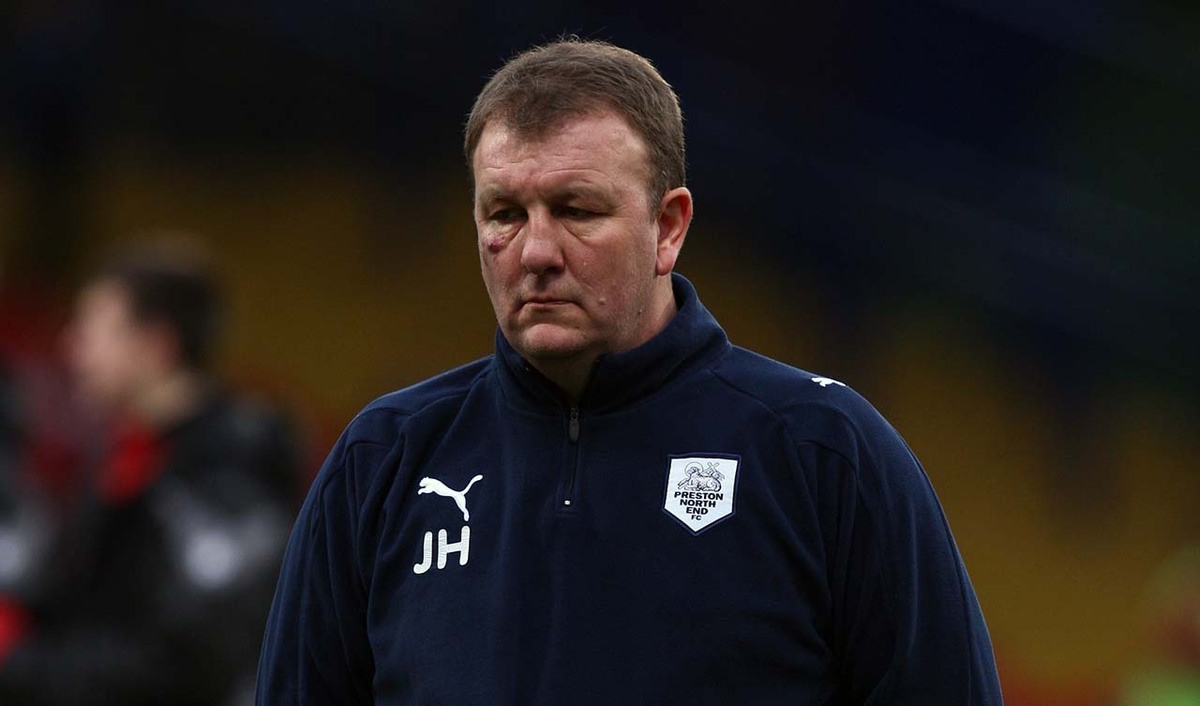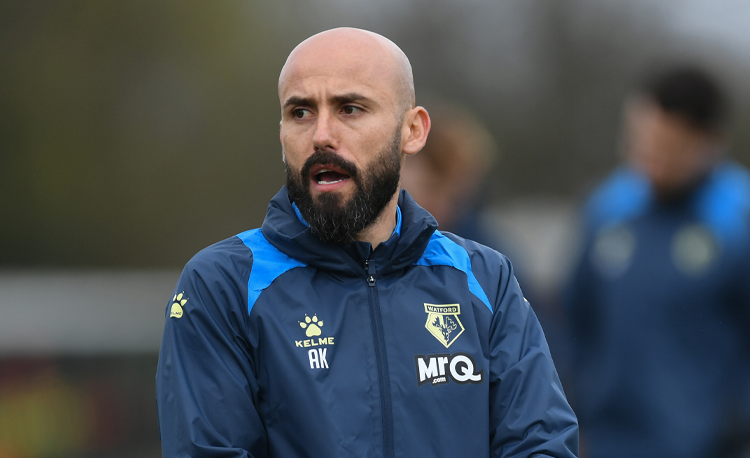You are viewing 1 of your 1 free articles
The dedicated defence
This session is all about defensive positions. It looks at how players should act when the opposing team has the ball, working firstly with units and then with all of the team together. It’s important to practise this in order to retain defensive shape when out of possession. Players need to look at which side to show, which side to mark, as well as assessing defensive distances and planning how to win the ball back. This is relevant to every match we play in, and we practise this each week.
| Area | Up to a full pitch |
| Equipment | Balls, cones, goals, mannequins |
| No. of Players | Up to 21 |
| Session Time |
Unopposed and opposed back four 10mins each, 8v6 25mins, Full pitch game 35mins |
This session is all about defensive positions. It looks at how players should act when the opposing team has the ball, working firstly with units and then with all of the team together.
It’s important to practise this in order to retain defensive shape when out of possession. Players need to look at which side to show, which side to mark, as well as assessing defensive distances and planning how to win the ball back.
This is relevant to every match we play in, and we practise the session each week.
What do I get the players to do?
Unopposed back four
The first set-up coaches players in adopting the correct position in relation to the ball, and each other. Four mannequins occupy perceived attack positions (two centre-forwards and two wingers). The coach moves the ball from side to side, backwards and forwards. The nearest man presses the ball, while the back four move in relation – side-to-side, squeezing out and dropping off (1).
1
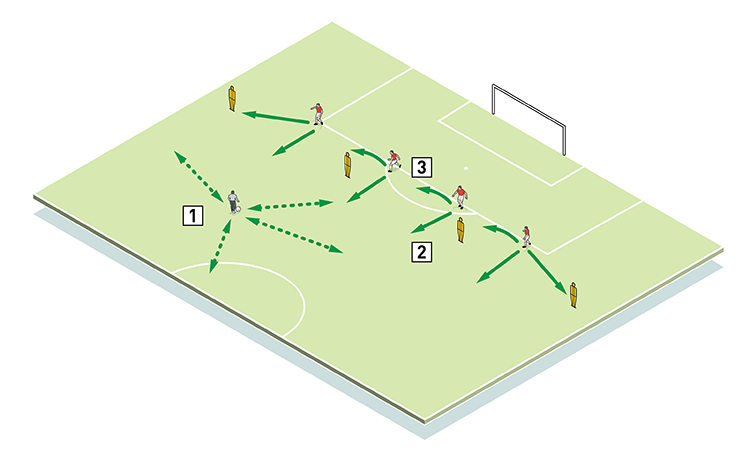
2. A defender moves forward when he is the nearest man to the ball
3. Defenders must work side-to-side in relation to the ball
Opposed back four
Now the mannequins are replaced with attackers, who are all two-touch. Attackers are not looking to score though, they just keep the defenders moving – forwards and backwards (2), and side to side (3).
2

2. Defenders react to the ball going wide by moving across the pitch
3. A defender moves forward when he is the nearest man to the ball
3

2. In particular, the full-back must quickly recover to mark his man
3. Other players move in relation to the ball whilst staying close to their man
Defenders must mark on the correct (goal-)side, should be tight, remaining close enough to the ball to affect play. The nearest defender must assume a position as if he is about to win the ball, using good communication with team mates at all times.
8v6 attacking overload
Now we bring in additional players to make an 8v6 (4). Attacking full-backs are two-touch and all other players all-in. Attackers can now score; if the defending team wins the ball it must find the coach.
4
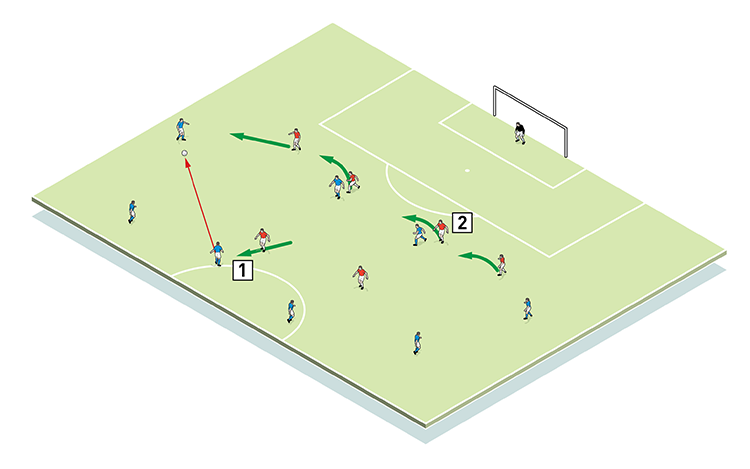
2. The back four again moves in relation to the ball
Defenders adopt the same principles as before, but full-backs must now ensure they get out to the wide men quickly (because wingers are being supported by other wide attackers) (5), halting their forward momentum, showing them down the line and stopping crosses. Centre-backs move across when the ball is played wide, and the opposite full-back tucks in to leave the furthest attacker, but he must be ready to recover. Defensive midfielders work across the ball.
5
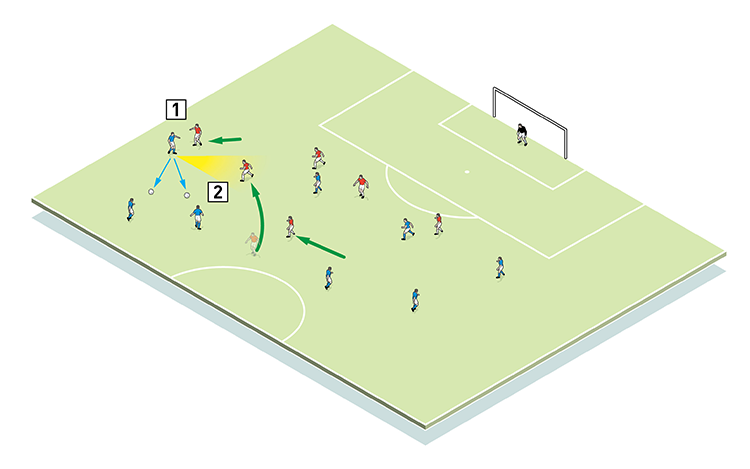
2. Defensive midfielders assist the full-back closing off forward passing opportunities
Full-pitch game
This is 9v9 outfield plus a neutral who plays for the attacking team. Attacks begin with the keeper feeding a centre-back. Opposing centre-forwards must show one way to play, therefore making play predictable, and enabling other defenders to get into their positions in relation to the ball (6).
6
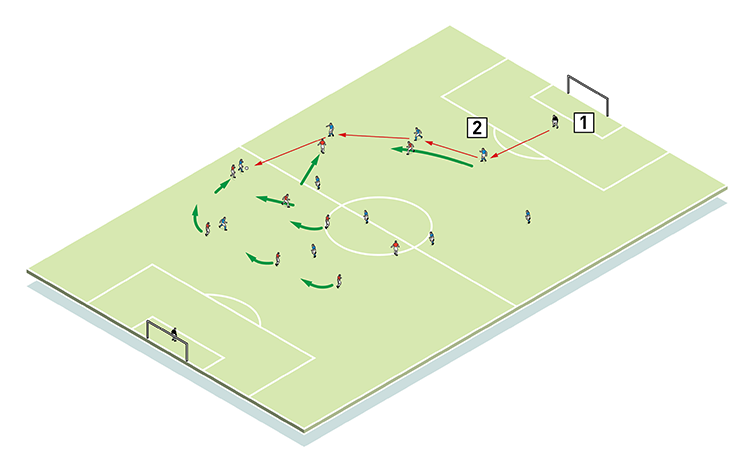
2. The attacker forces the receiving centre-back to play either left or right in stimulating the patterns of defensive movement previously practised
As before, the nearest man presses, while the midfield screens the front, closing down if the ball goes into that area.
Related Files
Editor's Picks
Deep runs in the final third
Using the goalkeeper in build-up play
Pressing principles
Intensive boxes drill with goals
Penetrating the final third
Creating and finishing
My philosophy
Pressing initiation
Compact team movement
Coaches' Testimonials

Alan Pardew

Arsène Wenger

Brendan Rodgers

Carlos Carvalhal

José Mourinho

Jürgen Klopp

Pep Guardiola

Roy Hodgson

Sir Alex Ferguson

Steven Gerrard
Coaches' Testimonials

Gerald Kearney, Downtown Las Vegas Soccer Club

Paul Butler, Florida, USA

Rick Shields, Springboro, USA

Tony Green, Pierrefonds Titans, Quebec, Canada
Join the world's leading coaches and managers and discover for yourself one of the best kept secrets in coaching. No other training tool on the planet is written or read by the calibre of names you’ll find in Elite Soccer.
In a recent survey 92% of subscribers said Elite Soccer makes them more confident, 89% said it makes them a more effective coach and 91% said it makes them more inspired.
Get Monthly Inspiration
All the latest techniques and approaches
Since 2010 Elite Soccer has given subscribers exclusive insight into the training ground practices of the world’s best coaches. Published in partnership with the League Managers Association we have unparalleled access to the leading lights in the English leagues, as well as a host of international managers.
Elite Soccer exclusively features sessions written by the coaches themselves. There are no observed sessions and no sessions “in the style of”, just first-hand advice delivered direct to you from the coach.
